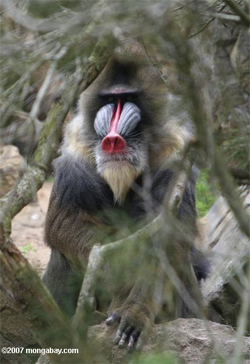The opportunity to conserve a one million hectare tract of rainforest in Cameroon is fast dwindling due financial pressures in the Central African country, reports a bulletin from the Ngoyla Mintom Foundation.
In 2002 the government of Cameroon suspended logging rights and extended an offer to protect Ngoyla Mintom — a forest reserve that houses 4,000 lowland gorillas, 1,500 endangered chimpanzees, 3,000 forest elephants and an important population of vulnerable Mandrills — provided someone step forward to pay for it. To date there have been no takers. Now facing a mounting economic crisis, the government of Cameroon says it will soon concession Ngoyla Mintom for logging. Conservationists say the move would have a “devastating” impact on wildlife and the environment.
 Ngoyla Mintom, together with bordering Nki National Park and Dja Wildlife Reserve in Cameroon, Minkébé National Park in Gabon and Odzala National Park in Congo, form part of a 15 million hectare continuous forest area, that supports Mandrills (above) as well as other charismatic species of wildlife. Photo by Rhett A. Butler |
“Many areas of Cameroon have been extensively logged in recent decades, and the effect has been devastating, both for the important species that lived there, and the local environment. In particular, logging typically involves: the unselective removal of trees; the burning of understorey, and; the construction of many new roads, which open up and expose the rainforest to agricultural and other development,” said the Ngoyla Mintom Foundation in its February 2009 issue of Ngoyla Mintom News (www.NgoylaMintom.blogspot.com). “Moreover, it is expected that a similar fate would befall Ngoyla Mintom should logging concessions be granted there as currently planned.”
To stave off this fate the Ngoyla Mintom Foundation is urging the public to write Joseph Roland Matta, the Cameroon Vice Minister of Forestry and Wildlife, asking him to reverse his government’s recent decision. The organization is also calling upon conservation groups to provide funding to preserve Ngoyla Mintom. The Economist reported last year that the Cameroon government is seeking around $1.6 million per year — less than $2 per hectare — for the area.
Ultimate funding for Ngoyla Mintom could come from an unlikely source: its trees. Under Reducing Deforestation and Degradation (REDD), a proposed mechanism for fighting climate change by protecting tropical forests, Ngoyla Mintom could see tens of millions of dollars for keeping its trees standing. But REDD is only possible with upfront funding to finance project design and development. Without it, Ngoyla Mintom may well fall to the axe.
-
In the REDD? A look at the potential carbon value of Ngoyla Mintom
Presented last February by mongabay.com
Between 2000 and 2005 Cameroon lost an average of 1 percent of its forest cover each year. For calculating the potential revenue generated from REDD, this figure is applied to the 830,000 ha of Ngoyla-Mintom forest cover, amounting to a forecast annual loss of 8,300 ha.
Assuming emissions of 160 tons of carbon per hectare from logging, at $3 per ton of CO2, REDD would generate credits worth $64 million (net present value over 30 years using a 5 percent discount rate), well in excess of the $26 million in concession fees (NPV over 30 years at a 5 percent discount rate). The $38 million difference seems likely to more than make up the opportunity costs of forgoing the jobs and local development from timber harvesting.
These calculations err on the side of caution. Carbon emissions from the logging or deforestation of Ngoyla-Mintom would likely be considerably higher than the figures used, especially if the land was later converted for agriculture. Further, REDD credits are presently higher than $3 and European ETS credits currently trade for more than $30 per ton. Even so, the current model suggests that at a price point of $1.21, REDD credits would break-even with revenue from logging concessions.
How to Help
In particular it is important that
the government of Cameroon realize the strength of opinion
regarding the need to conserve Ngoyla Mintom and to avoid
the granting of logging concessions in the area. Individuals and
organizations interested in the fate of this globally important
rainforest are thus called upon to write to the Cameroon Vice
Minister of Forestry and Wildlife, urging him to reverse his
government’s recent decision, and to support the work of the
new foundation, using the contact details provided below. A
model letter is also provided, but it would have more force if
you added your own words and thoughts, and please be sure to
add your own name and address. Please email or write to:
Vice Minister, Hon. Joseph Roland Matta
Ministère des Forêts et de la Faune
Immeuble Ministériel N°2, Boulevard du 20 mai
B.P. 12489, Yaoundè, Republic of Cameroon
mattaroland (at) yahoo.fr
A SAMPLE LETTER TO Vice Minister Matta
[Your Address Here]
Dear Vice Minister Matta
I am writing to you concerning the Ngoyla Mintom rainforest
in the south of Cameroon and your government’s recent
decision to begin selling logging concessions for this area.
I understand that Ngoyla Mintom is a globally important
rainforest, incredibly rich in biodiversity – including
Mandrills, Gorillas, Chimpanzees and Elephants – and it also
forms a vital link between neighbouring protected areas in
Cameroon, Gabon and Congo, which will likely become
fragmented and degraded should Ngoyla Mintom be logged.
I thus call upon you to work to reverse your government’s
recent decision, and to support the work of the new Ngoyla
Mintom Foundation and others in their aims to financially
support the conservation and sustainable development of
Ngoyla Mintom as a viable economic alternative to logging.
Yours sincerely,
[Your name]







